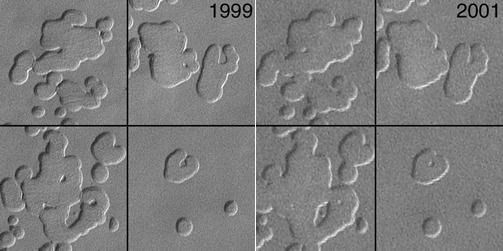 | ||
Swiss cheese features (SCFs) are curious pits in the south polar ice cap of Mars (Mare Australe quadrangle) named from their similarity to the holes in Swiss cheese. They were first seen in 2000 using Mars Orbiter Camera imagery. They are typically a few hundred meters across and 8 metres deep, with a flat base and steep sides. They tend to have similar bean-like shapes with a cusp pointing towards the south pole, indicating that insolation is involved in their formation. The angle of the Sun probably contributes to their roundness. Near the Martian summer solstice, the Sun can remain continuously just above the horizon; as a result the walls of a round depression will receive more intense sunlight, and sublimate much more rapidly than the floor. The walls sublimate and recede, while the floor remains the same. As the seasonal frost disappears, the pit walls appear to darken considerably relative to the surrounding terrain. The SCFs have been observed to grow in size, year by year, at an average rate of 1 to 3 meters, suggesting that they are formed in a thin layer (8m) of carbon dioxide ice lying on top of water ice. Later research with HiRISE showed that the pits are in a 1-10 meter thick layer of dry ice that is sitting on a much larger water ice cap. Pits have been observed to begin with small areas along faint fractures. The circular pits have steep walls that work to focus sunlight, thereby increasing erosion. For a pit to develop, a steep wall of about 10 cm and a length of over 5 meters in necessary.
